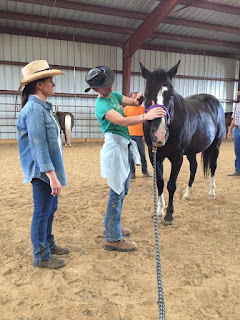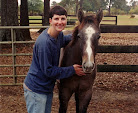If you were to draw a line at the point in this blog that
symbolized my most major horsemanship shift, this would be the place to draw
it: right at my first clinic with Mark Rashid.
I’ve been reading and loving Mark’s books for years, and
last year it suddenly occurred to me: I could study with him.
So I did.
And wow.
There have been a lot of wow moments in my history with
Lupin. In fact, my mind is kinda blown by the amount that I have been privileged to
learn and grow with him over the years, and by all the amazing teachers we’ve
had. But studying with Mark has been the Wowest of the Wows.
It’s not that Mark is some fancy hotshot who does
jaw-dropping things with his horses. In fact he’s quite the opposite: he’s
understated and quiet. And it’s not that he says so much that is so radically
different from what other horsemen say, though certainly he does say a lot of
fascinating things I haven’t heard before.
In fact, in a lot of fundamental ways his approach is very
compatible with that of others in terms of its content. But the feel that’s
behind it is, well—did I say this already?—wow.
Feel is a challenging thing to convey through words. It’s
not designed to be talked about, but to be felt. But since words are what I’ve
got, I’ll give it a go, and I’ll start with the feel coming from Mark that I
experienced myself.
* *
*
I actually met Mark for the first time at a demo he gave
last year while I was in Florida. I was in the middle of my
Horsenality/ Humanality course when I learned that Mark was just down the road.
All I could make it to was the demo, but that was enough. That was all it took
to make me absolutely determined to study with Mark. Here’s why:
Mark uses his demos to talk about the principles of the
martial art of aikido—principles that he incorporates into his horsemanship. He
gets auditors up and participating in pairs or groups, and he has us do
exercises that are literally hands-on: he asks us, for example, to try to move
someone by pushing them, and then to try again by starting, not with the idea
of moving the other person, but with the idea that “we” are going to move.
It’s hard to believe without feeling it what a difference
this makes. It puts your center of gravity and focus and everything else back
in the center of you, and it dismantles the tendency to look at things (like
other people and horses) as obstacles and problems. Indeed, it completely
rewires our tendency to focus on what’s “wrong” and gets us to envision instead the
positive outcome that we’re looking for.
This sounds like semantics, but it isn’t. And it isn’t just
psychology either. It’s also physiology. You soften and relax, not only because
you’re centered in yourself, but also because you’re no longer in a “me vs.
them” mentality; instead, you’re doing things together with others. The brace
in you melts, and that feeling travels through your hands into the other
person, and even to the person beyond them if there’s a third, starting a chain
reaction of irresistible relaxation.
When you’re on the receiving end of this process, the
surprise is no longer how easy it suddenly becomes to initiate movement in
others; the surprise is the sense of internal ease and happiness that floods
through you out of the blue, leaving you smiling and a little stunned at how
good it feels just to relax and go with.
And if you’re lucky enough to get to do a few exercises like
this with Mark one-on-one, you will know that this is not just profound
awesomeness, but game-changing, world-changing awesomeness. And I don’t just
mean with horses.
* *
*
My desire to learn as much as I could about this
awesomeness led me back to the same clinic this year, this time with
Lupin. I didn’t need the opening demo to get me fired up about being there, but
it was fantastic all the same.
Mark explained that when aikido works, you have
a positive impact on the other person, even if they have an aggressive intention
toward you. Your internal softness changes their outlook and intention, even as
you send them tumbling to the mat (which, however, will feel good to them if
you are doing aikido with real softness).
“How do you change the inside of you,” Mark asked, “so that
you can affect your partner in a positive way?”
I got the answer during one of my lessons with Mark when he demonstrated feel on a rope to me.
Holding the other end of the rope, he showed me how it feels when you lead with
hardness (usually unconscious hardness that we might even think feels fairly
soft), and then he showed me how it feels when you have the internal softness
that comes from relaxation.
 |
| photo courtesy of Jeane DeVries |
One moment I was standing there with my hand braced on a
taut rope; the next moment, without any external change on Mark’s part or any movement
of the rope, I felt my entire insides relax and I involuntarily let out a deep
sigh. How do you change the inside of you so that you can affect your partner
in a positive way? You soften inside, and you communicate that softness through feel, thereby creating softness in them. Amazing. And so beyond
any concept of a “soft feel” that I’d ever even thought of, let alone
experienced.
We’re not talking lightness here. We’re talking about a
profound feeling of peace. That is the essence of softness.
* *
*
Mark communicated this same sensation to me on the day of my
first lesson in a different way.
I felt more at ease at the prospect of studying with Mark
than I have with any other new instructor. I trusted him implicitly and knew
with certainty that it would be a hugely positive experience before I ever even
showed up with my horse.
Nonetheless, I still had a bit of the “first day of
something new” jitters. We started out by chatting a bit about what I wanted to
work on, and in doing so we touched on a topic that I have developed something
of an emotional charge about: leadership. Decades of going back and forth
between trying to do things peacefully and having others tell me that I’m not
being assertive enough have wreaked some havoc in my brain around this topic
and made me incredibly self-conscious about any apparent lack of “leadership”
with my horse.
I could go on and on, which is, in fact, what my brain began
doing as I talked to Mark. Though I was doing my best (and succeeding decently
well) at keeping it together, I have no doubt that Mark could tell I was in a
heightened emotional state. What he did about it was really impressive, and it
was this: he did nothing.
Actually, that’s not true. I’ve been in that same scenario
with other people who did nothing—people who, like Mark, just continued calmly
talking with me until I settled back down and then carried on. But Mark did
something more than that. I can’t tell you exactly how he did it, and I didn’t
realize until later on that he had done it. It wasn’t just that he stayed calm.
It was that he held a center of calmness that he waited for me to find, and
when I did, I was at peace again.
It was the feeling of peace that let me
know that Mark was doing something different. In that same scenario with other
people the external trajectory would look the same, but as I got back to
whatever we were working on, I wouldn’t return to it with a sense of
peace. I would still be right on the verge of getting emotional again the next time I
felt challenged. I might finally earn some hard-won peace by having a
breakthrough with my horse or reaching a new understanding, but I would be
exhausted by the process.
With Mark I felt just the opposite: I felt lighter and more
peaceful with each lesson. There was no feeling of the weight of great learning at the end of the lessons—just a sense that something had shifted. But it wasn’t a
shift I needed to analyze or work to keep. It was just a shift I needed to feel
and continue to allow to happen. I have never felt less exhausted at the end of
a clinic. In fact, I felt good.
 |
| photo courtesy of Bo Reich |
That’s not to say that I moved into a zen bliss trance where
nothing could bother me. Periodically another emotionally charged subject came
up—our lack of motivation/impulsion. But again, this was charged for me because
of my past experiences and perceptions, not because of Mark.
Indeed, it was Mark’s calm presence that gave me the space
and tranquility to realize just how charged I had allowed the issue to become
for me. Because my lessons with Mark were predominately peaceful spaces of finding
a new kind of feel rather than chaotic spaces of processing information and
trying to perform well, I could more easily recognize the baggage that I was
carrying around when it showed up. And I could more easily let it go and move back to a peaceful state myself.
I imagine that this is also how horses feel around Mark.
They may have histories that have created some emotional baggage for them, but
when they get in that emotional space, Mark doesn’t make a big deal of it, or get them busy, or do a bunch of things to “fix”
them. He just keeps his own calm, peaceful center and lets them find it.
It’s a remarkable thing to experience. And what is more
remarkable is that Mark can teach it. Am I going to find every opportunity I
can to learn it from him? You bet!
*Note*: To clarify, Mark is not a Parelli instructor. He does his own thing, and he writes delightful books about it. You can find all of them here. I have yet to read anything by him that wasn't fascinating and enjoyable, but if you're interested in the topic of this blog post, his newest book A Journey to Softness will blow your mind—in a calm, understated, and subtle way, of course!










